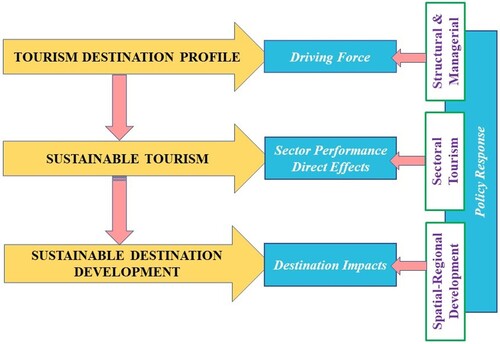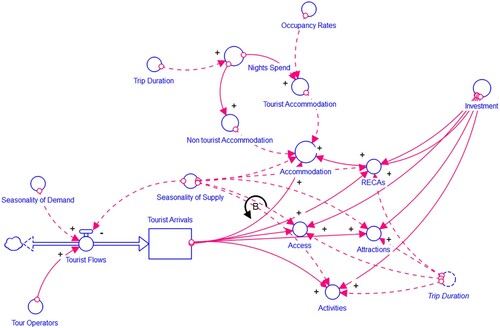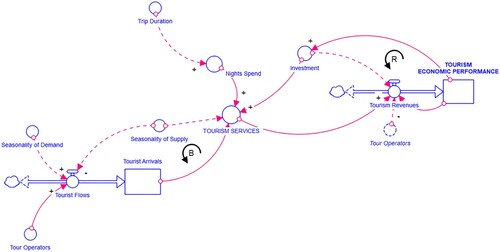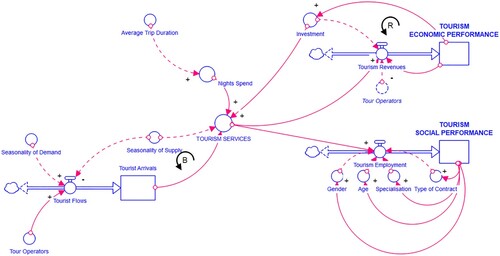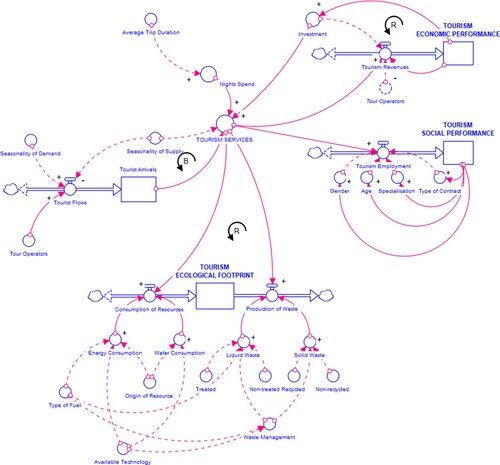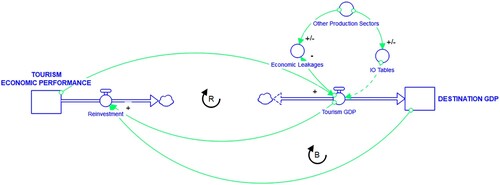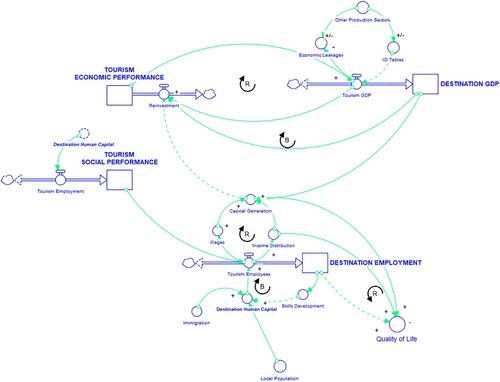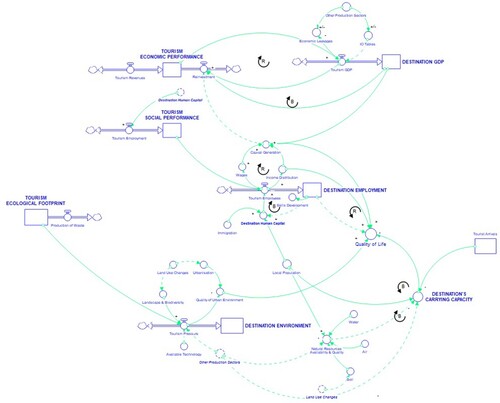ABSTRACT
The adoption of the UN Sustainable Development Goals (SDGs) set the strategic vision for the next decade. Yet, their operationalisation, more so, at the tourism industry and destination level is fraught with challenges leaving destination managers and tourism officials to appeal for meaningful and effective decision support tools. This paper addresses the academic and institutional recommendations for monitoring and implementing the SDGs in the tourism sector. It introduces a systems thinking framework (the Tourism Sustainability Assessment Framework (TSAF)) for delineating the dependencies and dynamics of variables and monitoring indicators in a tourism industry versus tourism destination ecosystem of relationships. The TSAF proposes a roadmap for integrating information and data from the various nationally adopted tourism statistics frameworks to effectuate the assessment of tourism sustainability. A comparison along with the SDG indicators then accentuates the importance and necessity for industry-specific, effective units of measurement.
Introduction
Tourism destinations are inherently structured as dynamic complex systems. Tourism is broadly recognised as a system of multiple interacting and interdependent components conceptualised over the years from different perspectives: geographical, market, and stakeholders. Similarly, destinations can be seen as interrelated element systems that evolve through a dynamic adaptation to external and internal inputs. The underlying non-linearity of destination system relationships has been well-documented over the years (e.g. Baggio, Citation2008, Citation2020; Hall et al., Citation2018; Kadar & Gede, Citation2021; Pavlovich, Citation2014; Pearce, Citation2014). Yet, this pluralism of components and elements results in multiple interpretations of the definition of a tourism destination (Baggio, Citation2008), making its actual conceptualisation as a complex adaptive system “fragmented, incomplete, and without much general sense of direction” (Pearce, Citation2014, p. 141).
Such implications manifest beyond research objectives to practically and fundamentally affect destination management. Many scholars discuss the limitations of the reductionist paradigm to capture the dynamics of tourism destinations and advocate in favour of system thinking tools inspired by complexity or even chaos theory (Pearce, Citation2014). Currently, complexity within destination management research is usually addressed by limiting planning and decision making to particular aspects of tourism, level of authority, or stakeholder interest (Lorencini Gazoni & Marachado da Silva, Citation2021). By unpacking the destination system in this way, the larger picture is lost, along with consideration of longer-term consequences or their induced combined effect on the extended system. Systems thinking thus offers the integrative lens of a tourism destination’s inter-relationships, perspectives, and boundaries to effectuate the conceptualisation and operationalisation of system opportunities and failures.
Sustainability has driven over the years fundamental changes in tourism planning and management at both the micro and macro levels. The efforts are only gaining prominence in light of the UN’s Sustainable Development Goals (SDGs) and 2030 Agenda for Sustainable Development. Still, to date, there is no consensus on a tourism sustainability framework within the destination ecosystem. Even if the adoption of the SDGs has been broadly applauded by both the institutional and academic communities as a major step towards that direction, sustainable tourism models and frameworks still show little to no direct attention to the SDGs (Rasoolimanesh et al., Citation2020). What UNWTO (Citation2016, p. 4) acknowledged as “fundamental measurement issues” goes beyond the well-recognised conceptual and methodological challenges around indicator measurement and data collection. It signifies fundamental concerns around indicators’ appropriateness, relevance, and integration potential to capture sustainability within the tourism system. With the SDG monitoring relying on available data from the official national system accounts and with no established framework for their integration, the measurement of tourism sustainability resembles more of a jigsaw puzzle.
This paper introduces the Tourism Sustainability Assessment Framework (TSAF), a systems thinking structure for the complete delineation of sustainability in the tourism destination ecosystem. The TSAF stems conceptually from the fundamentals of sustainability and systems theory to provide a bird’s-eye view of the way a tourism destination ecosystem operates over time, how it behaves and how it adapts dynamically to internal and external disturbances. Its theoretical contribution lies in the dynamic delineation and organic identification of sustainability catalysts, inhibitors, and information gaps depending on the specifics of each destination system. The TSAF’s overall managerial utility lies in its capacity to support the operationalisation of the monitoring (delineated system structure), assessing (dominant feedback loops), and forecasting (latent feedback loops) of sustainability of various planning and management interventions. As such it supports decision-makers to identify system strengths to be enhanced and unanticipated failures to be avoided. The TSAF’s operationalisation builds on the International Recommendations for Tourism Statistics (IRTS 2008) (UN Statistical Division, Citation2010) and the Statistical Framework for Measuring the Sustainability of Tourism (MST) (UNWTO, Citation2016) and relies on secondary data collected through Systems of National Accounts (SNAs), Tourism Satellite Accounts (TSAs) and Systems of Integrated Environmental and Economic Accountings (SEEAs). Finally, the paper explores monitoring gaps along the SDGs and proposes directions for the development of more effective and tourism-appropriated SDG indicators.
Literature review
Systems thinking and tourism destinations’ sustainability
From a systems theory perspective, sustainability is the ability of Socio-Ecological Systems (SESs) to transform or transition in the face of constantly changing conditions (Williams et al., Citation2017). Systems thinking, rooted in von Bertalanffy’s (Citation1968) systems theory, is the interpretive method of critically analysing between and across system relationships (context and connections), perspectives (stakeholder interests), and boundaries (scope and scale) to support change management and decision making. Systems thinking in the context of tourism destination management overcomes reductionist management theories and caters to the complexity of the highly interdependent tourism systems (Baggio, Citation2008). Tourism Destination Observatories have been long employed as knowledge management instruments to monitor externally and internally induced change and facilitate decision making within the context of sustainable destination management. Challenges around data consistency and coherence highlight the necessity for smaller scale and more localised structures to capture the entailed level of destinations complexity (Plan Blue/UNEP/MAP, Citation2012).
Tourist destinations can be considered as open systems where boundaries are confined within their management/governance jurisdiction. Even if flows and linkages within the destination system are known, Hall et al. (Citation2018) argue that their causal factors, as well as the directions and strength of causality, are not always clear. In fact, what seems to be still missing is the identification and, if possible assessment, of the feedback loops within the destination system particularly when it comes to its sustainability. Even if the drivers and barriers of tourism destination sustainability performance have been well-documented in the extensive lists of sustainability indicators (UN, Citation2020; UNWTO, Citation2016), these feedback loops are essential to capture the magnitude of the effect and impact of change drivers, like destination supply and demand, on the sustainability performance of a destination (Mendola & Volo, Citation2017; Torres-Delgrado et al., Citation2021).
Williams et al. (Citation2017) reviewed the literature on the intersection of systems thinking and sustainability management, concluding that a systems approach is not yet prevalent and that most current research focuses on organisational behavioural change, leadership, innovation, and transition management. Sedarati et al. (Citation2019) systematic literature review further confirms little focus on the macro/destination scale probably attributed to the overall complexity associated with scales, disciplines, and dimensions of both concepts within the SES. Lorencini Gazoni and Marachado da Silva (Citation2021) proposed a system dynamic model for tourism development management comprising seven units: tourists; natural and cultural resources; attractions; infrastructure/superstructure; tourism services-equipment; tourism demand; and competitive rivalry. With the latest being the more expansive in capturing a destination’s performance and development, there is still a necessity and potential for the exploration of the operational application of systems thinking in the context of sustainability in tourism destinations.
Tourism sustainability at the destination level
The tourism sustainability literature is a rich venue of in-depth yet singular case study frameworks, tailor-made to the unique characteristics of each destination and often susceptible to the over-aggregation or disaggregation of multiple sustainability components or criteria weightings (Blancas et al., Citation2016). Under the prism of each destination’s uniqueness, sustainability assessment remains subject to the interests and objectives of each researcher and their synthesising capacity to address any prominent issues of interest, leaving limited space for replicability or the exploration of the same relationships (Buckley, Citation2019; Pearce, Citation2014). This plethora of approaches only demonstrates the lack of a consensus over an appropriate process for the development of a universal sustainability assessment framework, hence undermining a more generalised operationalisation of the concept.
Even if attributed to the abstractness, vagueness of terminology, or case specificity of sustainability as a concept, in reality, the confusion is deeply rooted in the distinction between those factors and variables that define sustainability at the sector level (sustainable tourism) over those that relate to the sustainability of the destination as a whole (sustainable tourism destination) (Glyptou, Citation2022). With the exception of the Global Sustainable Tourism Council criteria (https://www.gstcouncil.org/), there is still inadequate clarification between the concepts (and assessment frameworks) for tourism sustainability at the industry level and sustainable tourism development at the destination level. For tourism, sector sustainability does not necessarily ensure sustainability at the destination level, as the latter is subject to the characteristics of the particular destination and its ability to manage the sector. Even if the assessment of sector sustainability has improved through the introduction of quality certification schemes, the operationalisation of sustainability at the destination level or the identification of what qualifies a destination as sustainable remains still sparse (Fennell & Cooper, Citation2020). Such systemic delineation between the elements defining the tourism profile of a destination (cause), the performance and direct effect of the sector per se, and the overall (direct, indirect, induced, and catalytic) impacts of tourism on the host destination is essential to understand the integrative behaviour of a tourism destination system.
Further confusion seems to stem from the conceptual discrepancy between the perceived tourism destination boundaries implying the reference unit for tourism pressure assessment, the evaluation of entailed impacts, or the consideration area for spatial planning and management initiatives. Over the years, a widely accepted definition of a tourism destination proved rather elusive, posing a real challenge for the identification of broadly accepted units of measurement, hence studying system behaviour (Pearce, Citation2014). The challenge is further exacerbated by public tourism policies and management schemes (including the SDGs) that merely focus on assessing tourism performance and impacts at the national level rather than delineating a destination management approach that generates added value while being subject to destinations’ unique specificities and carrying capacity (subnational level). As such tourism destination benefits and impacts are unevenly aggregated within national performance and pressure indicators and neither specifically nor sufficiently accounted for in any of the territorial units of statistics SNAs, TSAs, and SEEAs. With these accounts being the primary source of official data on tourism performance, any expectation of a voluntary framework driving the official assessment of destination sustainability for management purposes is rather elusive.
Sustainable tourism destination management and the SDGs
The management of complex adaptive SESs requires the identification and understanding of system processes, functions, and dynamics in a way that translates knowledge into a capacity for the attainment of sustainability and systems resilience. The process is effectuated by means of performance indicators that serve as units of measurement of progress towards the achievement of sustainability. Sustainability indicators are evidence-based tools that condense and communicate complex system information in a meaningful way for decision-makers. They support the rapid assimilation of key information to address system priorities, offer guidance for further exploration when required, but primarily promote self-regulation of sustainability within the tourism system (Rasoolimanesh et al., Citation2020). In that regard, sustainability indicators enable the continuous monitoring of sustainability-oriented transitions to inform appropriate responses and interventions within the inherent complexity of a tourism destination SES.
Even though sustainable tourism is explicitly mentioned in only three of the SDGs (SDG #8, SDG #12, and SDG #14) and is primarily associated with targets 8.9, 12b, and 14.7, the expectation of its contribution to the achievement of all the 17 SDGs is widely acknowledged (Hall, Citation2019). With 169 actionable targets developed around the 17 SDGs, tourism among the other sectors needs to monitor its performance and contribution towards the 2030 Agenda for Sustainable Development along a series of 247 indicators (231 unique ones). Even if not legally binding, national governments are expected to take ownership of the Global Indicator Framework for the SDGs (A/RES/71/313) to monitor their sustainability performance at regional and national levels along concrete units of reference. The overarching framework acknowledges the conceptual and methodological limitations related to the gathering and the measurement of data through their initial allocation in three distinctive Tier classifications, which only demonstrated the challenge of adopting indicators fully operational at the national level (Glyptou et al., Citation2022).
Methodology
The conceptual framework
The TSAF builds on environmental functions analysis (de Groot, Citation1992a, Citation1992b) to separate a change from an “impact, that is a change in the functions (products and services) provided” by the system (Vanclay, Citation2002, p. 191). This core differentiation between the effects of a change in the performance of a sector and the impacts that this change entails for the host system is the basis for the clarification between sustainability at the sector level over its contribution towards the sustainability of the host tourism destination itself.
The TSAF operationalises sustainability as change-effect and impact dynamics in the context of destinations and along the broadly adopted Triple Bottom Line (TBL). presents TSAF’s along four distinct stages which effectuate: (i) the tourism profiling of a destination, (ii) the assessment of tourism sustainability, subject to performance changes in the sector, (iii) the contribution of tourism to the destination’s sustainability, and (iv) the TSAF ascribes to each stage, policy interventions that target specific system weaknesses.
Considering tourism as the main driver of change in a destination, stage 1 of the TSAF accounts for the specific elements of tourism supply, demand, and organisation of the tourism market that determine the profile of the host destination. Terminologies, typologies, and boundaries might vary depending on the characteristics of the destination, the area, or the background of the researcher (Pearce, Citation2014), yet this stage encapsulates the core structure of tourism activity at each destination. Hence, any policy interventions addressing structural and organisational issues including tourist flows, seasonality, investments, branding, or positioning will be rooted back in this initial stage.
Tourism inflows in a destination stimulate the first round of economic and social effects and environmental pressures that define the performance of the sector and are directly linked to the activation drivers of the previous stage. Stage 2 of the TSAF encapsulates the non-connected performance and direct effects of the tourism sector, hence serving as a benchmark for the assessment of tourism performance while mediating transitions towards the sustainability of the sector (sustainable tourism). Responses at this stage may relate to sectoral restructures such as the development of niche and special interest tourism (product differentiation), the minimisation of the industry’s ecological footprint, or greater control over tour operators’ dependency.
Once the effect of changes in tourism sustainability performance is assessed, Stage 3 reduces the direct effects of tourism on the specificities of the host destination’s prosperity, carrying capacity, availability of human and natural resources, or the cumulative performance of other production sectors. Hence, the overall and total multiplier impact of tourism is assessed with respect to the destination’s available financial, human, and natural capital. Even if operational changes mediate the sustainable performance of the sector, it is their rendition of the availability and quality of the host destination’s resources and functions that determine the significance of tourism impacts and benchmarks sustainability at the destination level. Responses at this stage may relate to broader spatial-regional policies that dictate the level of dependency of the host destination on tourism, production linkages to other sectors, leakage of financial and human capital or destination’s carrying capacity, and the quality of life of the local population.
The operational tool
In line with the principles of dynamic systems modelling, the TSAF’s operational structure is depicted through closed and/or non-linear stock and flow diagrams (SFDs), which allow for an intuitive understanding of system complexity (Sterman, Citation2000). SFDs illustrate the structural interdependence of variables in a system of relationships and visualise complexity through systemic propositions of feedback loops. SFDs capture the rates of magnitude and change of system control variables and effectuate the dynamic calibration of the destination system through interim reliability checks. The tool adopts the systems thinking language of symbols and constructs (Meadows, Citation2009) to capture a system’s behaviour in four basic components: stocks, flows, converters, and both action (solid) and information (dashed) connectors. Further on it highlights balancing (B) or reinforcing (R) feedback loops, implying consistent stabilising or self-enhancing causal behaviours within the system.
Baseline SFD
At the core of the TSAF’s operational structure lies the main stock of tourism performance shaped over the years through management interventions. Paraphrasing Meadows (Citation2009, p. 18), tourism sustainability performance is “the present memory of the history of changing inflows within the destination system”. The inflows are rooted in the system drivers (Stage 1 of the conceptual model) and consider unit conversion to capture actions and processes that cause a change in the stock: revenues (economic), employment opportunities (social), and ecological footprint (environmental). The exact quantification of stocks and inflows is beyond the scope of this paper. Recognising the discourse on the socio-cultural dimension of sustainability (Bimonte & Punzo, Citation2016), the TSAF deliberately reduces this dimension to employment to conveniently link social effects and impacts to the other systems’ stocks and flows. A follow-up version of the framework needs to better aggregate elements of the socio-cultural dimension (e.g. cultural authenticity, locals’ perceptions, or stakeholder involvement).
Reinforcing loops could exponentially drive growth behaviour within an SES. Yet, within the limits-to-growth archetype balancing loops are employed to account for the profile and carrying capacity of the host destination. There lies the essence of differentiating between the sustainability performance of the tourism sector over its contribution to the sustainability of the destination. It is the fact that in operational terms, a sector’s sustainability can be exponentially reinforced (continuously improved tourism performances) while at the destination level, tourism’s contribution is constrained by the specificities of the destination and the relative importance of all other production sectors along the priorities of the community (Duarte Alonso & Nyanjom, Citation2017).
Tourism activation at destination level loop
Tourism at the destination level is activated by the arrival of tourists. Arrivals in are depicted as a reservoir stock whose magnitude is subject to the capacity and seasonality of a destination’s supply (balancing loop), but primarily to the seasonality of demand often dictated by the involvement of tour operators (seasonality of charter and low-cost flights) (Vetitnev et al., Citation2016).
Tourists activate various reinforcing loops through the consumption of supply services here summarised under Dickman’s (Citation1997) 5As (accommodation, activities, attractions, access at destination level, and various amenities primarily restaurant and cafes) for a specific point in time (annual record). The availability and capacity of services calibrate the arrival inflows through balancing interim loops (B). Supply is parameterised along IRTS’s (2008) list of indicators including elements of size, typology, and capacity with the potential to expand to elements of quality and performance characteristics (e.g. disability/family friendly/vegan/ethically certified venues). Destination supply is subject to both seasonality (operational period) and tourism-induced investment via the revenues and economic contribution reinforcement loop in (OECD, Citation2018).
Demand is expressed through the magnitude of the key stock of tourist arrivals, the duration of the trip, and the tourists’ profile summarised in attributes of origin, holiday arrangement, mode of transportation, and accommodation type (IRTS, 2008). To encapsulate the effect of interim dynamics, the accommodation converter considers demand statistics for both official and non-official tourism accommodation (such as AirBnB) establishments through the discrepancy (leakages) between border surveys (nationality differentiation) and accommodation surveys (establishment differentiation). The main control variable for the accommodation loop is the number of nights spent, which informs the official accommodation occupancy rates (IRTS, 2008).
The association of tourism activation variables to the SDG targets and indicators is rather challenging. A direct connection to tourism flows can be made only to indicator 9.1.2. and an indirect to 11.2.1 (Appendix Table 1). The remaining variables defining the destination profile and the key market characteristics (e.g. type of trip of organisation, duration of stay, and preferences) are left to be coupled to the TSAs.
Tourism sustainability performance loops
Tourism consumption activates direct economic, social effects, and environmental pressures. Tourism revenues constitute the basis of the economic performance of the sector. depicts the economic effect SFDs of 5A-related expenditure components under the aggregated term “Tourism Services”. A key balancing loop calibrates arrivals based on the availability and seasonality of services; tourism’s economic effect is also subject to a key reinforcing loop. The loop is conditional and subject to the type of holiday, the type of product, and indirectly to all the activation drivers of the previous stage, which dictate elements of tourist typology, behaviour, and motivations. The economic effect of the sector is a function of both tourist volumes and preferences, expressed through the per capita expenditure patterns and overall tourism revenues.
The social effect tourism loop () is deliberately reduced to direct employment in tourism-characteristic industries (IRTS, 2008). The magnitude of the effect is dependent on the stock of human capital (Figure 7), yet the sectoral effect is different from the destination impact. The former accounts for the number of jobs generated irrespective of the origin of the employee, whilst the latter relates to the contribution of tourism in the alleviation of unemployment in the local population. The MST framework (UNWTO, Citation2016) for the SDG measurement reiterates this intention, recommending their disaggregation, where relevant, by income, sex, age, race, ethnicity, migratory status, disability, geographic location, and other characteristics.
The environmental footprint loop considers industry operational pressures, referring to the consumption of resources (water and energy) and the production of waste (solid and liquid) (Niemeijer & de Groot, Citation2008). An extension of tourism infrastructure aggravates the permanent environmental footprint evaluated by the consequent land-use changes (EEA, Citation2011). The TSAF parametrises the environmental footprint along the Global Footprint Network methodology (GFN, Citation2013) to translate tourism ecological pressure into the demand for bio-productive surface (global hectares (gha)) either directly consumed by the yield or necessary to absorb the generated waste and CO2 emissions. In this way, it goes beyond the SEEAs that operate on the basis of economic-environmental transactions (EUROSTAT, Citation2019a). Other methodologies might be more appropriate or accurate in parametrising tourism’s environmental footprint, yet this exploration is beyond the scope of this paper ().
The intensity of tourism’s ecological footprint is subject to variables including the typology of fuel used for energy production, variations in technology and processing techniques applied in water production and waste assimilation (such as recycling, landfilling, or waste treatment), the local yield factor (indicating the average bio-productive capacity depending on the typology of local natural resources), national or international legislation on tourism quality standards (such as energy and water consumption levels per nights spent), variations in accommodation typologies and the typology of the tourism product offered to determine tourism flows of specific motivational patterns (green tourism versus mass tourism), and accommodation preferences as per the activator drivers identified in the previous stage of the framework.
The mapping of TSAF variables along the tourism industry SDG indicators is summarised in Table 2 (Appendix). The SDG indicators relate mainly to the variables of Tourism Investment and Reinvestment, encompassing elements of accessibility to financial services with a focus on small-scale industries (e.g. 9.3.1. and 9.3.2.) and total resource flow from donor countries (e.g. 10.b.1). Interestingly, a number of targets related to investment in rural infrastructure and technology (e.g. 2.a.) remain solely coupled around indicators of specific sectors (agriculture in this case). Similarly, Target 8.10. is solely attached to indicators around the number of commercial bank branches (8.10.1) or the proportion of adults with a bank account (8.10.2.), when it could be more relevant to other sectors including tourism businesses.
Within the limitation of considering tourism employment as the key variable of social performance, the SDG system offers an extensive number of indicators to account directly and indirectly for tourism employment at an aggregated or disaggregated level. Indicator 8.b.1, for instance, could account for the training and development of industry-specific skills. As indicated in Table 1 (Appendix), there seems to be sufficient consideration, even if indirectly, to the descriptive characteristics of tourism employment such as gender, age, specialisation, and type of contract. Interestingly, by June 2021, the only indicator under Target 8.9. By 2030, devise and implement policies to promote sustainable tourism that creates jobs and promotes local culture and products, which remains indicator 8.9.1. Tourism direct GDP as a proportion of total GDP and growth rate, giving a clear indication of the underlying assessment standards of sustainability in the industry.
Finally, to collate information on the tourism ecological footprint one would need to consider a number of SDG targets and indicators around the material consumption footprint (e.g. 12.2.1) and waste management (e.g. 12.4.1), or more specifically indicators on energy consumption (13.2.2), water consumption efficiency (6.4.1), the production of liquid (6.3.1), solid waste (11.6.1), and food waste (12.3.1). Still, the information is rather fragmented and incomplete to assess the impact along the whole life cycle of each industry, as it does not consider the origin of the source (imported or not); the available technology neither for its usage nor for its waste management treatment (e.g. recycling), all of which are essential for sustainability management as per any green industry certification. There is hence the need for a better and stronger integration with the System of Integrated Environmental and Economic Accountings and its indicators.
Sustainable tourism destination performance loops
Within the established tourism accounts, tourism’s contribution to the prosperity of the destination is measured in terms of the tourism-generated gross domestic product (TGDP) (). The magnitude of contribution is subject to the multiplier effect (Input/Output [IO] tables and SNAs) and linkages to other production sectors which can be either positively or negatively correlated depending on the specifics of the local economy structure (Fletcher, Citation1989). A strong multifaceted destination with low dominance of one sector ensures minimum capital leakages and promotes destination sustainability (Cárdenas-García & Pulido-Fernández, Citation2019). TGDP serves as an indicator of tourism’s relative importance and economic dependence at the destination level.
The stage is subject to two feedback loops; a reinforcing one suggesting that higher revenues and TGDP drive reinvestment in the sector (OECD, Citation2018) and a balancing one suggesting that for sustainable management, reinvestment and capital allocation should be considered along destination priorities and local well-being (UNWTO, Citation2018b). The two loops run simultaneously only to change their dominance over time. Revenues are exponential at first when the reinforcing loop is dominant, implying that increased tourist flows generate higher TGDP and investment in tourism supply, however, as other destination priorities affecting local’s quality of life come into focus, reinvestment in tourism supply slows down and the balancing loop becomes dominant. Data can be collated through the supply/use and IO tables of the System of National Accounts.
The contribution of tourism to employment is counter-balanced by the availability and skills of human capital at the destination level (). A reinforcing loop at the sector level links economic profit and wages to investment for training, or complementary employment opportunities rebalancing the human capital stock. Other than population demographics, the magnitude of tourism’s contribution here lies in the capacity of the sector to retain or better attract a permanent population and to contribute towards skills development (UNWTO, Citation2018b).
For the economic and social dimensions, balancing elements are imposed through financial and human capital restrictions (UN, Citation2010). Yet, it is the environmental carrying capacity that regulates growth and balances the exponential growth of reinforcing loops. Key elements to consider are the quality and availability of resources, land-use management, and urbanisation along with the cumulative demand for space and resources from all other production sectors. The reductionist approach considers the carrying capacity of a tourism destination as constant. Systems thinking enables the dynamic adaptation of limits to growth to evolving destination realities when under crisis or in the cases where impacts of interventions reduce temporarily or permanently the tolerance and carrying capacity of a system ().
SDG targets and indicators most relevant to the assessment of sustainability at the tourism destination level are summarised in Table 3 (Appendix). For the economic dimension, tourism economic value and contribution are not directly linked to any of the SDG indicators as, for instance, it is happening for the manufacturing sector through indicator 9.2.1. The importance of tourism for the economy of many destinations could be recognised by a similar tourism-relevant indicator. There is of course clear mention in Target 12.b around sustainable development impacts for sustainable tourism that creates jobs and promotes local culture and products, yet the relative indicator 12.b.1 calls for the implementation of standard accounting tools to monitor the economic and environmental aspects of tourism sustainability, which remains rather vague and generic considering that most countries have not been able to develop nor embed effectively the TSAs or the SEEAs. Interestingly, none of the included indicators makes any reference to either the economic leakages, the multiplier effect, or connections with other production sectors in the face of developing partnerships.
The social dimension is integrated into targets and indicators related to income distribution (e.g. 10.4.1) and capital generation (e.g. 8.2.1), which need to eventually acquire a more sectoral focus. Similarly, indicators on skills development like indicator 1.a.2 could focus again on government spending on essential services per sector, particularly for destinations with heavy reliance on tourism. Other indicators refer to the quality of life (e.g. 3.8.2) and immigration (3.c.1) with the primary focus on health services. Such indicators need to be further extended to consider the conditions that destination retain their population throughout the year (e.g. birth and death rates), so they do not have to migrate in pursuit of a better quality of life. Sustainability in this regard should consider the overall resilience of destinations.
Lastly, the quality of the destination environment is well embedded within the various SDG targets and indicators. It is possible to identify information on landscape and biodiversity (e.g. 15.4.1), quality of the urban environment (11.4.1), land-use change (11.3.1), and urbanisation (11.7.1), yet a sectorial disaggregation is required to assess accurately the impact of each sector in a destination’s carrying capacity versus its additive manifestation. Similarly, a disaggregation of information is necessary to accurately monitor the impact of each sector on the quality and availability of natural resources (air, water, soil, and land use). For instance, the indicator 6.4.2, needs to be addressed at the sector level to understand the press that tourism, for instance, is pressing on water availability of destinations, especially in areas of water shortages. Another example is the indicator 15.3.1, which again would be most useful if relevant to the sector level to facilitate the specific scale of land-use alterations, as a result of tourism expansion pressure, particularly in wetlands, coastal, and protected areas.
Discussion and critique
The adoption of the SDGs by the 2015 United Nations Sustainable Development Summit aimed to set some guidance towards the homogenisation of sustainability assessment in all production and service sectors. Yet as early as 2016, United Nations World Trade Organisation (UNWTO) acknowledged the fundamental measurement issues related to the monitoring of sustainability in tourism. The issue seemed to revolve primarily around the challenges in data collection and indicator measurement, yet it disregarded completely the fundamental question of indicators’ appropriateness, relevance, and integration potential to depict the whole image of sustainability within the tourism destination system. There lies the contribution of the TSAF to provide a sustainability-delineated framework for capturing the tourism system dynamics and interconnections. This is an essential prerequisite for the fitting-in of all relevant and available indicators and data (SNAs, TSAs, and SEFAs), the delineation of their cause–effect relations (TSAF’s complete SFD system is included in the Appendix), and the identification of measurement and indicator gaps for collecting more relevant and useful data.
The Statistical Framework for MST was introduced to integrate data from official system accounts (SNAs, TSAs, and SEEAs) in support of the SDG performance measurement. Notwithstanding the ongoing discussions around the relevance of sustainability at the national versus local destination level (UN, Citation2017; UNWTO, Citation2018a), there are still prominent methodological and practical challenges for implementing TSAs at lower than national levels (Frent & Frechtling, Citation2022; UNWTO, Citation2018a) or the progress in the natural capital accounting through the SEEAs (Hein et al., Citation2020). EUROSTAT (Citation2019b, p. 4) in their state-of-affairs regarding TSA implementation in Europe recognises that while most countries have a “well-established system of statistics to track tourism demand in terms of domestic and outbound trips, tourist accommodation and tourist expenditure […] they don’t measure the overall contribution of tourism to the economy”. Similarly, the 39th European Statistical System Committee (EUROSTAT, Citation2019b, p. 2) recognises that environmental accounts are used by a growing number of European Union states, yet “most if not all of these initiatives require more comprehensive and robust data sets to monitor and evaluate progress towards the agreed policy objectives” and call for SDG indicators to monitor progress through a more integrative approach between goals and evidence. It thus seems that there is still a long way until the complete integration and coupling of all statistical systems at the national level, leaving implementation at the destination level as a work in progress.
The effectiveness of the expected integration remains elusive considering that tourism sector performance remains still diluted within the system's accounts, as often integrated with other service sectors. The analysis performed for this paper reveals a similar pattern for the SDGs. Considering that tourism is amongst the key-value sectors for many countries and even more regions and destinations, there is a need to develop more tailor-made indicators that capture both tourism performance and footprint similar to the sectors of agriculture and manufacturing. Obviously, the environmental impact of tourism is not comparable to that of agriculture or manufacturing, still, there is a clear need to assess the sustainability performance of tourism along its supply chain and life cycle through more detailed targets and criteria. With only three sector-specific SDG performance indicators, the tourism industry is left perplexed about their exact contribution. The TSAF adds to the tourism sustainability agenda by establishing a baseline system to clearly portray the type and variety of indicators necessary to assess and measure tourism sustainability performance both at the industry and destination levels. This provides the much necessary guidance for actions within the industry, especially under the shading of accountability between the industry and the hosting destination (OECD, High Level Political Forum Citation2017).
Moreover, within the recognition of the need to detach sustainability from mere growth, sustainability indicators have been often criticised for an overemphasis on market-oriented approaches and functional managerialism (Hall, Citation2019). This is hard to argue against, considering that the attainment of sustainable tourism within the SDGs is directly associated with indicators that aim to provide a macroeconomic appraisal of the contribution of tourism to economic growth and job creation as in the case of indicator (8.9.1 Tourism direct GDP as a proportion of total GDP and in growth rate) or the generic indicator 12b.1 on the implementation of standard accounting tools to monitor the economic and environmental aspects of tourism sustainability, without any further guidance around that. Within its system dynamics structure, the TSAF simultaneously considers indicators along the TBL but primarily considers their cause–effect relationships along the tourism destination ecosystem.
Through capturing the balancing and reinforcing interconnections along the TBL (with the potential to extend further), it helps to put in perspective and challenge the reductionist management archetypes summarised by Mai and Smith (2015). In this regard, the TSAF helps to identify the need for appropriate indicators to accurately and timely detect the point in the lifecycle of a system where the feedback loop turns from “a virtuous to a viscous” cycle putting in potential jeopardy the whole sustainability performance of the system. This system thinking structure oversees the short-term balancing effect (e.g. economic benefits) but rather captures the overall unintended and even reinforced consequences that revert the system or exacerbate the problem after the delay (e.g. dependence/multiplier effect, production footprint against destinations’ tourism development and carrying capacity). In this regard, the approach allows for an adjusted application within the specificities of local destination scale, and destination profile, as driven by the typology of key features and attributes, as well as the destination life cycle and socio-economic context.
Effective, accountable, and inclusive institutions are considered essential to achieving the SDGs. Despite national governments taking the lead on the initiative, the participation of all stakeholders is deemed paramount for the success of the endeavour (UNWTO, Citation2018a). The absence of a clear governance-driven goal is evident in the SDGs. There is definitely an improvement in terms of gender equality and female empowerment (SDG 5), still, participation and inclusivity of all stakeholders and actors are deemed essential for destinations’ transition towards sustainability (Ashton Adie et al., Citation2020). The analysis performed in this paper reveals the necessity for more appropriate indicators to monitor sustainable governance and its contribution to the achievement of the SDGs within the different development and policy contexts. By narrowing down the analysis at the destination level (stage 1) the TSAF accounts indirectly for the governance and tourism development impact on the various typologies of destinations. Still, the whole structure and national standardisation of data collection and indicator monitoring raise questions as to whether there is room for bottom-up policy action at the local destination level. This is particularly relevant as there are tourism-relevant SDGs that have no dedicated targets or indicators applicable (Glyptou et al., Citation2022). Capturing the tourism system delays, the TSAF promotes a culture beyond “quick fix” managerial responses and triggers the necessity for active stakeholder participation in the data collection and monitoring process at the local destination level. More importantly, though, it nurtures a system thinking cause–effect culture and mentality where all stakeholders can visually see the benefits from their contribution and accountability or the implications of their absence therein. The latest might reveal issues of power and participation inequalities depending on the local socio-economic context, hence requiring further attention around engagement and incentive indicators at the local level (Fennell & Cooper, Citation2020).
Conclusions
The operationalisation of sustainability at the tourism destination level has been an elusive goal for many decades. The vision of the SDGs reiterates the intention, yet in practice, the endeavour remains a victim of indicator appropriateness, scale, relevance, and integration potential along the connected national system accounts. This paper introduces the TSAF, a roadmap for the dynamic delineation of sustainability in the tourism destination system. The TSAF adopts a system thinking approach that caters to the inherent complexity of tourism destination systems and sustainability, dynamically adjusted to the specificities, destination typology, and destination life cycle through a series of control variables. By capturing the cause–effect–impact behaviour of the tourism system through SFDs and feedback loops, the TSAF effectuates the differentiation between sustainable tourism over a sustainable tourism destination. This differentiation proved pivotal during the comparison of the TSAF and SDGs indicator systems, with obvious implications for business accountability and the adoption of effective measurement indicators.
The TSAF is more expansive than exhaustive in tourism destination ecosystem elements and dynamics. It offers the basis for the development of a roadmap for the operational understanding of its behaviour and interconnections and proposes a foundation structure for the fitting-in of monitoring knowledge in a systemic way, while revealing information gaps along the SDGs application scales and context. The TSAF has obvious limitations, particularly when accounting for the social and environmental dimensions of sustainability, which should be further considered in a future more detailed version of the framework. The TSAF’s generalised structure allows for the dynamic adaptation and evaluation of tourism sustainability within various destination contexts and levels of development (core control variables), still, a more detailed inclusion of typology-specific information could advance the level of analysis’ sensitivity and reliability. Additionally, the dimension of governance should be added through a specific set of indicators as it dictates, to a great extent, the local system interconnections and dynamics. The TSAF considers indirect elements of destination governance (stage 1), yet the detail of information is dissolved amidst data aggregation at the national level. The TSAF’s sensitivity analysis could be improved through the coupling along local knowledge from tourism observatories and stakeholders.
During the UNWTO High Impact Meeting (March 2021), most country representatives plead for meaningful, feasible, and practical tools that can effectuate the application of the SDGs and support the design of informed policies. Despite the advances in methodologies and data collection techniques, the sustainability measurement paradox persists. We are still caught in the vicious circle of valuing what can be measured instead of measuring what is of value. Without a clear structure of what needs to be meaningfully measured and how the information makes sense as a whole, any effort to fit in data from the existing system accounts resembles more of a jigsaw puzzle. The TSAF helps to identify needs and gaps of tourism sustainability monitoring along the SDGs and raises the need for further adaptation along spatial scales and destination development. A further exploration and development of more appropriate indicators are necessary, yet this was beyond the scope of the current paper.
Disclosure statement
No potential conflict of interest was reported by the author.
References
- Ashton Adie, B., Amore, A., & Hall, M. C. (2020). Just because it seems impossible, doesn’t mean we shouldn’t at least try: The need for longitudinal perspectives on tourism partnerships and the SDGs. Journal of Sustainable Tourism, (Dec 8), 1–16. https://doi.org/10.1080/09669582.2020.1860071
- Baggio, R. (2008). Symptoms of complexity in a tourism system. Tourism Analysis, 13(1), 1–20. https://doi.org/10.3727/108354208784548797
- Baggio, R. (2020). Tourism destinations: A universality conjecture based on network science. Annals of Tourism Research, 82(2020), 102929. https://doi.org/10.1016/j.annals.2020.102929
- Bimonte, S., & Punzo, L. F. (2016). Tourist development and host–guest interaction: An economic exchange theory. Annals of Tourism Research, 58, 128–139. https://doi.org/10.1016/j.annals.2016.03.004
- Blancas, F. J., Lozano-Oyola, M., González, M., & Caballero, R. (2016). Sustainable tourism composite indicators: A dynamic evaluation to manage changes in sustainability. Journal of Sustainable Tourism, 24(10), 1403–1424. https://doi.org/10.1080/09669582.2015.1122014
- Buckley, R. (2019). Measuring sustainability of individual tourist behavior. Journal of Travel Research, 58(4), 709–710. https://doi.org/10.1177/0047287518765694
- Cárdenas-García, P. J., & Pulido-Fernández, J. I. (2019). Tourism as an economic development tool: Key factors. Current Issues in Tourism, 22(17), 2082–2108. https://doi.org/10.1080/13683500.2017.1420042
- de Groot, R. S. (1992a). Functions of nature: Evaluation of nature in environmental planning, management and decision making. Wolters-Noordhoff.
- de Groot, W. T. (1992b). Environmental science theory: Concepts and methods in a one-world problem-oriented paradigm. Elsevier.
- Dickman, S. (1997). Tourism: An introductory text (3rd ed.). Hodder Education.
- Duarte Alonso, A., & Nyanjom, J. (2017). Local stakeholders, role and tourism development. Current Issues in Tourism, 20(5), 480–496. https://doi.org/10.1080/13683500.2015.1078782
- European Environment Agency (EEA). (2011). Landscape fragmentation in Europe. Joint EEA-FOEN report (EEA Report No 2/2011). https://www.eea.europa.eu/publications/landscape-fragmentation-in-europe
- EUROSTAT. (2019a, February 7). European strategy for environmental accounts 2019–2023. Work Programme Objective 05. 39th Meeting of the European Statistical System Committee (ESSC). Publications Office of the European Union. ESSC 2019/39/03/EN.
- EUROSTAT. (2019b). Tourism satellite accounts in Europe: The 2019 edition. KS-FT-19-007-EN-N. Publications Office of the European Union.
- Fennell, D. A., & Cooper, C. (2020). Sustainable tourism: Principles, contexts and practices. Channel View Publications.
- Fletcher, J. E. (1989). Input-output analysis and tourism impact studies. Annals of Tourism Research, 16(4), 514–529. https://doi.org/10.1016/0160-7383(89)90006-6
- Frent, C., & Frechtling, D. C. (2022). Regional tourism satellite accounts: Towards international comparability. Tourism Review, 77(1), 97–112. https://doi.org/10.1108/TR-07-2020-0315
- Global Footprint Network (GFN). (2013). The national footprint accounts (2012 ed.).
- Glyptou, K. (2022). Tourism sustainability indicators. In D. Buhalis (Ed.), Encyclopedia of Tourism Management and Marketing. Cheltenham: Edward Elgar Publishing.
- Glyptou, K., Amore, A., & Ashton Adie, B. (2022). From aspirations to applications: The SDG and the importance of indicators. In A. Farmaki, A. Levent, & X. Font (Eds.), Planning and managing sustainability in tourism (pp. 13–25). Cham: Springer
- Hall, C. M. (2019). Constructing sustainable tourism development: The 2030 agenda and the managerial ecology of sustainable tourism. Journal of Sustainable Tourism, 27(7), 1044–1060. https://doi.org/10.1080/09669582.2018.1560456
- Hall, C. M., Prayag, G., & Amore, A. (2018). Tourism and resilience: Individual, organisational and destination perspectives. Channel View Publications.
- Hein, L., Bagstad, K. J., Obst, C., Edens, B., Schenau, S., Castillo, G., Soulard, F., Brown, C., Driver, A., Bordt, M., Steurer, A., Harris, R., & Caparrós, A. (2020). Progress in natural capital accounting for ecosystems. Science, 367(6477), 514–515. https://doi.org/10.1126/science.aaz8901
- Kadar, B., & Gede, M. (2021). Tourism flows in large-scale destination systems. Annals of Tourism Research, 87(2021), 103113. https://doi.org/10.1016/j.annals.2020.103113
- Lorencini Gazoni, J., & Marachado da Silva, E. A. (2021). System dynamics framework for tourism development management. Current Issues in Tourism, 1–22. https://doi.org/10.1080/13683500.2021.1970117
- Meadows, D. H. (2009). Thinking in systems: A primer. Green Publishing Co.
- Mendola, D., & Volo, S. (2017). Building composite indicators in tourism studies: Measurements and applications in tourism destination competitiveness. Tourism Management, 59, 541–553. https://doi.org/10.1016/j.tourman.2016.08.011
- Niemeijer, D., & de Groot, R. S. (2008). A conceptual framework for selecting environmental indicator sets. Ecological Indicators, 8(1), 14–25. https://doi.org/10.1016/j.ecolind.2006.11.012
- OECD. (2017). Policy coherence as a means for addressing dilemmas in SDG implementation. Paris: OECD Publishing.
- OECD. (2018). Towards investment and financing for sustainable tourism. In OECD (Ed.), OECD tourism trends and policies 2018. (pp. 93–116). Paris: OECD Publishing.
- Pavlovich, K. (2014). A rhizomic approach to tourism destination evolution and transformation. Tourism Management, 41, 1–8. https://doi.org/10.1016/j.tourman.2013.08.004
- Plan Bleu /UNEP /MAP Regional Activity Center. (2012). Towards an observatory and a “Quality Label” of tourism sustainability in the Mediterranean. Plan bleu, Valbonne. Blue Plan Papers 12 (2012).
- Pearce, D. G. (2014). Toward an integrative conceptual framework of destinations. Journal of Travel Research, 53(2), 141–153. https://doi.org/10.1177/0047287513491334
- Rasoolimanesh, S. M., Ramakrishna, S., Hall, C. M., Esfandiar, K., & Seyfi, S. (2020). A systematic scoping review of sustainable tourism indicators in relation to the sustainable development goals. Journal of Sustainable Tourism, 1–21. https://doi.org/10.1080/09669582.2020.1775621
- Sedarati, P., Santos, S., & Pintassilgo, P. (2019). System dynamics in tourism planning and development. Tourism Planning & Development, 16(3), 256–280. https://doi.org/10.1080/21568316.2018.1436586
- Sterman, J. D. (2000). Business dynamics–systems thinking and modeling for a complex world. Irwin McGraw-Hill.
- Torres-Delgrado, A., Lopez-Palomeque, F., Sanz, B. E., & Font Urgell, X. (2021). Monitoring sustainable management in local tourist destinations: Performance, drivers and barriers. Journal of Sustainable Tourism, ahead-of-print, 1–22. https://doi.org/10.1080/09669582.2021.1937190
- UN. (2010). International recommendations for tourism statistics 2008 (IRTS 2008). Department of economic and social affairs, statistics division. ST/ESA/STAT/SER.M/83/Rev.1.
- UN. (2017). 2017 synthesis of voluntary national reviews. New York, NY: United Nations.
- UN. (2020). Global indicator framework for the Sustainable Development Goals and targets of the 2030 Agenda for Sustainable Development.
- United Nations. Statistical Division. (2010). International recommendations for tourism statistics 2008 (No. 83). United Nations Publications.
- UNWTO. (2016). Measuring sustainable tourism: Developing a statistical framework for sustainable tourism. UNWTO Statistics and Tourism Satellite Account Programme. http://cf.cdn.unwto.org/sites/all/files/docpdf/mstoverviewrev1.pdf
- UNWTO. (2018a). Contribution from the countries in the Committee on Tourism Statistics and Tourism Satellite Account of the UN WTO (UNWTO). Seventh Meeting of the Inter-Agency and Expert Group on the Sustainable Development Goal Indicators. 10–12 April, Vienna: Austria.
- UNWTO. (2018b). Tourism for development – volume II: Good practices. Madrid, Spain: UNWTO Publications.
- Vanclay, F. (2002). Conceptualising social impacts. Environmental Impact Assessment Review, 22(3), 183–211. https://doi.org/10.1016/S0195-9255(01)00105-6
- Vetitnev, A., Kopyirin, A., & Kiseleva, A. (2016). System dynamics modelling and forecasting health tourism demand: The case of Russian resorts. Current Issues in Tourism, 19(7), 618–623. https://doi.org/10.1080/13683500.2015.1076382
- von Bertalanffy, L. (1968). General system theory: Foundations, development. George Braziller.
- Williams, A., Kennedy, S., Philipp, F., & Whiteman, G. (2017). Systems thinking: A review of sustainability management research. Journal of Cleaner Production, 148, 866–881. https://doi.org/10.1016/j.jclepro.2017.02.002
Appendix
Table A1. Tourism activation at the destination level is relevant to SDG indicators.
Table A2. Tourism sustainability performance relevance to SDG indicators.
Table A3. Tourism destination performance relevance to SDG indicators.

